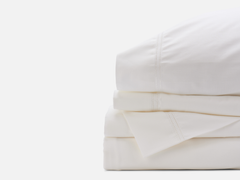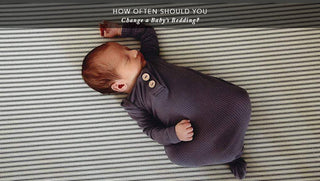In most cases, your baby will spend more of their time asleep than they will awake. Sometimes, they’ll spend their sleeping time in car seats, high chairs, curled up in your arms, or even on the nursery floor. But if there’s one place they’ll spend a lot of their sleeping time, it’s in their cribs.
Since your baby spends so much of their first few months lying in bed, it makes sense to take special care of their bedding, especially when washing it. But how often should you change a baby’s bedding?
The Importance of Changing a Baby’s Bedding
A lot of parents are worried about the idea of over-sanitizing our kid’s world. After all, many of us grew up running around barefoot and rolling around in the mud. Those are the activities that help build up our immune systems and keep us from developing allergies.
While this is true, the fact is that babies’ skin is incredibly delicate. As babies sleep, dirt, sweat, and dead skin accumulate in the bedding’s fibers. That can lead to a less-than-comfortable sleeping situation. Not to mention, given it’s still at least a year or so until potty training, you’ll want to keep the bedding fresh.
How Often We Should Change Baby Bedding
So how often should you change a baby’s bedding? Naturally, that may vary from week to week, especially depending on your baby’s age, frequency of nighttime accidents, and health. But this breakdown will help you build a normal wash schedule for your baby’s bedding.
Sheets
You should only keep bedsheets in the crib for babies younger than a year old. As we said, it’s OK to expose your baby to some germs. And washing your baby’s sheets too often can lead to them getting worn down prematurely.
Typically, washing your baby’s bedding at least once a week or every other week is enough to keep them clean without over-washing them. Of course, you can wash them more frequently if the sheets look stained.
Swaddling Blankets
Since swaddling blankets lie closer to the baby’s skin and catch more of a baby’s sweat, saliva, and other fluids, you will want to wash them more frequently. Otherwise, they’ll become nasty. Unfortunately, there isn’t an expert-approved number for how often you should wash your baby’s swaddling blankets.
This means you may need to play it by ear—or nose, in this case. If your baby’s swaddling blankets become dirty more quickly, you may need to wash them every three days or more. If not, you can always throw them in weekly or whenever you wash the sheets. Our recommendation is to have as many swaddling blankets as possible.
Mattress Pad
Mattress pads are a game-changer as far as keeping your baby’s mattress clean. Mattress pads keep stains from seeping through and damaging your crib mattress, helping it last longer. Of course, since it’s doing the heavy lifting in keeping stains out, they’ll most likely need cleaning sooner or later.
Luckily, a layer of sheets designed to keep the pad clean cover it. Because of that, you can usually get away with not cleaning them as frequently. You should be OK as long as you clean it at least once a month.
Comforters
As we said, babies shouldn’t have anything in their cribs other than sheets when they’re under a year old. But once they’re over a year, you can add a blanket, quilt, or comforter.
As with grown-up blankets, you don’t need to wash comforters nearly as much as sheets. If you’re washing your baby’s sheets once a week, you can wash the comforters once every other week.
Pillowcase
Pillows are another addition that comes after the year marker. Unlike the comforter, you should wash your baby’s pillowcases even more frequently than the sheets. Babies drool, after all, even when they’re awake. And all that drool accumulates along with sweat and dandruff that can make your baby sick.
Your best bet is to wash your baby’s pillowcase at least once or twice a week. This is another situation where it’s a good idea to have a few extra sets of pillowcases.
Baby Bumpers
In years gone by, baby bumpers were the norm. The idea was to protect babies by preventing them from bumping their heads on the sides of the crib, or worse, getting stuck.
However, most people these days agree that baby bumpers don’t offer much protection for babies. In some cases, they can even cause greater harm. It’s best to skip adding a baby bumper to your crib. But if you do, you can usually stick to a once-a-month cleaning regimen.
Principles To Follow When Washing Crib Bedding
But washing your baby’s bedding isn’t just about the frequency. You’ll want to make sure you use the right techniques to make sure you clean the bedding without ruining it. Here are a few key principles to keep in mind:
- Wash linens like the sheets, pillowcases, and comforters on a higher heat
- Wash mattress pads on a lower heat
- Wash all bedding on a gentler cycle to protect the fabric
- Use natural detergents instead of harsh chemicals
- Dry your sheets at a lower temperature to prevent damage
A Note on Stains
For days when your babies’ sheets are extra messy, it pays to treat the stains before you put the bedding in the washing machine. There are several ways to do this. One way is to soak your sheets in a mixture for an hour before putting them in the wash or apply it directly to the stain.
However, don’t use bleach for the mixture. Along with being harsh, bleach can make stains worse when you apply them to unwashed sheets. Instead of bleach, try:
- Borax
- Lemon juice
- Hydrogen peroxide
- White vinegar
Hanging your babies’ sheets in the sun after you finish washing them will also help lighten some of those more stubborn stains.
Your baby will spend a lot of time sleeping. Make sure they get the best sleep possible with Red Land Cotton’s cotton crib bedding. Your baby will have a comfortable sleep, and you’ll rest easy knowing you have an all-natural, American-made set of sheets that’ll last a long time.


